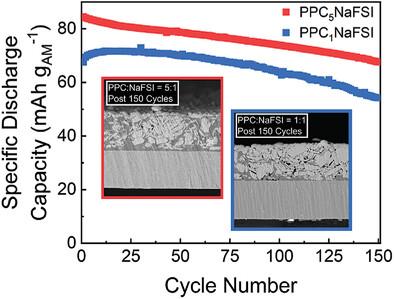Our official English website, www.x-mol.net, welcomes your
feedback! (Note: you will need to create a separate account there.)
Polycarbonate-Based Solid-Polymer Electrolytes for Solid-State Sodium Batteries
Small ( IF 13.0 ) Pub Date : 2023-12-28 , DOI: 10.1002/smll.202311839 Erick Ruoff 1 , Steven Kmiec 1 , Arumugam Manthiram 1
Small ( IF 13.0 ) Pub Date : 2023-12-28 , DOI: 10.1002/smll.202311839 Erick Ruoff 1 , Steven Kmiec 1 , Arumugam Manthiram 1
Affiliation

|
Solid-polymer electrolytes comprised of polypropylene carbonate (PPC) and varied sodium bis(fluorosulfonyl)imide (NaFSI) salt concentrations are investigated for implementation as a conductive solid polymer electrolyte into solid-state cathode composites utilizing a sodium-layered oxide active material. The ionic conductivity generally increases with NaFSI salt content, reaching ≈1 mS cm−1 at 80 °C at the highest salt concentration (PPC:NaFSI = 0.5:1). Through an all-in-one slurry casting method, Na2/3Ni1/3Mn2/3O2 cathode composites are fabricated in which the dispersed PPC electrolyte acts as the primary binder. Enabled by a bilayer polymer electrolyte system, cycling performance with the PPC cathode electrolyte is optimized with respect to salt concentration and anode material. The best cyclability is achieved with a moderate salt concentration electrolyte (PPC:NaFSI = 5:1), showcasing an initial capacity of 83 mA h g−1 with a remarkable 80% capacity retention after 150 cycles at C/5 rate and 60 °C. The superior performance of the lower salt concentration electrolyte is attributed to better electrochemical stability, as confirmed by linear sweep voltammetry and online electrochemical mass spectrometry measurements. These results underscore the potential of carbonate-based polymer electrolytes and the importance of balancing electrolyte conductivity and stability in cell design.
中文翻译:

用于固态钠电池的聚碳酸酯基固体聚合物电解质
研究了由聚碳酸亚丙酯 (PPC) 和不同浓度的双(氟磺酰基)亚胺钠 (NaFSI) 盐组成的固体聚合物电解质,以将其作为导电固体聚合物电解质应用到利用钠层氧化物活性材料的固态阴极复合材料中。离子电导率通常随着NaFSI盐含量的增加而增加,在最高盐浓度(PPC:NaFSI = 0.5:1)下在80°C时达到约1 mS cm -1 。通过一体式浆料浇铸法,制备了以分散的PPC电解质作为主粘合剂的Na 2/3 Ni 1/3 Mn 2/3 O 2正极复合材料。在双层聚合物电解质系统的支持下,PPC 阴极电解质的循环性能在盐浓度和阳极材料方面得到了优化。使用中等盐浓度电解质 (PPC:NaFSI = 5:1) 实现了最佳循环性能,初始容量为 83 mA hg −1 ,在 C/5 倍率和 60 °C 下循环 150 次后容量保持率高达 80% 。线性扫描伏安法和在线电化学质谱测量证实,较低盐浓度电解质的优异性能归因于更好的电化学稳定性。这些结果强调了碳酸酯基聚合物电解质的潜力以及平衡电解质电导率和稳定性在电池设计中的重要性。
更新日期:2023-12-28
中文翻译:

用于固态钠电池的聚碳酸酯基固体聚合物电解质
研究了由聚碳酸亚丙酯 (PPC) 和不同浓度的双(氟磺酰基)亚胺钠 (NaFSI) 盐组成的固体聚合物电解质,以将其作为导电固体聚合物电解质应用到利用钠层氧化物活性材料的固态阴极复合材料中。离子电导率通常随着NaFSI盐含量的增加而增加,在最高盐浓度(PPC:NaFSI = 0.5:1)下在80°C时达到约1 mS cm -1 。通过一体式浆料浇铸法,制备了以分散的PPC电解质作为主粘合剂的Na 2/3 Ni 1/3 Mn 2/3 O 2正极复合材料。在双层聚合物电解质系统的支持下,PPC 阴极电解质的循环性能在盐浓度和阳极材料方面得到了优化。使用中等盐浓度电解质 (PPC:NaFSI = 5:1) 实现了最佳循环性能,初始容量为 83 mA hg −1 ,在 C/5 倍率和 60 °C 下循环 150 次后容量保持率高达 80% 。线性扫描伏安法和在线电化学质谱测量证实,较低盐浓度电解质的优异性能归因于更好的电化学稳定性。这些结果强调了碳酸酯基聚合物电解质的潜力以及平衡电解质电导率和稳定性在电池设计中的重要性。































 京公网安备 11010802027423号
京公网安备 11010802027423号